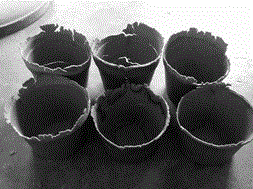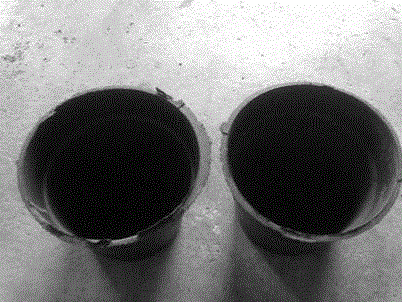Method for improving plasticity of wood fiber raw material
A wood fiber raw material and plastic technology, applied in the field of materials, can solve the problems of inability to realize environmental protection and energy saving production, limit the large-scale production of wood fiber, secondary pollution, etc. The effect of secondary pollution
- Summary
- Abstract
- Description
- Claims
- Application Information
AI Technical Summary
Problems solved by technology
Method used
Image
Examples
Embodiment 1
[0017] Collect 1000kg of harvested wheat straw, after natural air-drying (moisture content 12%), use a pulverizer to crush into particles with a particle size of about 3mm, add 100kg of straw decomposing agent (accounting for about 11.4% of the dry weight of the straw), add 2kg of starch and an appropriate amount of urea, so that the carbon-nitrogen ratio of the mixed material is 30:1, add quicklime to adjust the pH to 7.5, and finally add water until the moisture content of the mixed material is 65%, stir the mixed material into a conical shape and put it On bare ground and covered with plastic film, monitor once an hour and record the temperature of the mixed material. When the temperature of the material does not change or decreases, the material needs to be fully turned to keep the oxygen content inside the lignocellulosic raw material at about 20%. Fermentation The time is 20 days, the accumulated temperature of the material is 900°C, the fermentation is finished, and the ...
Embodiment 2
[0020] Mix the collected rice husk and rice straw at a ratio of 1:1, take 1000kg of the mixture and dry it naturally until the moisture content is 8%, use a pulverizer to crush the mixture into particles with a particle size of about 2mm, and then add 150kg of decomposed compost (equivalent to wood 16.3% of the fiber raw material), add 3kg of soybean meal and an appropriate amount of urea, so that the carbon-nitrogen ratio of the mixed material is 40:1, add quicklime to adjust the pH to 7.6, and finally add water until the moisture content of the mixed material is 75%, stir evenly, Put the mixed material into the fermentation tank and cover it with a plastic film. Monitor and record the temperature of the mixed material every hour. During this period, according to the temperature change of the fermented material, the material needs to be fully turned (the oxygen content inside the wood fiber raw material is 30%), the plasticizing time is 15 days, and the accumulated temperat...
Embodiment 3
[0023] After natural drying, the rice husk with a moisture content of 15% was crushed into rice husk particles with a particle size of about 2.5 mm, and its rheological properties were measured by a torque rheometer, and 1000 kg of rice husk particles were taken, and 100 kg of decomposed compost (equivalent to 11.8% of the dry weight of rice husk particles), add 2kg of starch and an appropriate amount of urea to make the carbon-nitrogen ratio of the mixed material 35:1, add quicklime to adjust the pH to 7.5, and finally add water to the mixed material The moisture content is 65%, stir evenly, pile the mixed material into a cone shape and place it on the bare ground, and cover it with a plastic film, monitor once an hour and record the temperature of the mixed material. Fully turn the pile so that the oxygen content inside the lignocellulosic raw material is 25%. The accumulated temperature of the material in this example is 800°C. After about 15 days of fermentation, the plas...
PUM
| Property | Measurement | Unit |
|---|---|---|
| particle diameter | aaaaa | aaaaa |
| particle diameter | aaaaa | aaaaa |
| particle diameter | aaaaa | aaaaa |
Abstract
Description
Claims
Application Information
 Login to View More
Login to View More - R&D
- Intellectual Property
- Life Sciences
- Materials
- Tech Scout
- Unparalleled Data Quality
- Higher Quality Content
- 60% Fewer Hallucinations
Browse by: Latest US Patents, China's latest patents, Technical Efficacy Thesaurus, Application Domain, Technology Topic, Popular Technical Reports.
© 2025 PatSnap. All rights reserved.Legal|Privacy policy|Modern Slavery Act Transparency Statement|Sitemap|About US| Contact US: help@patsnap.com


